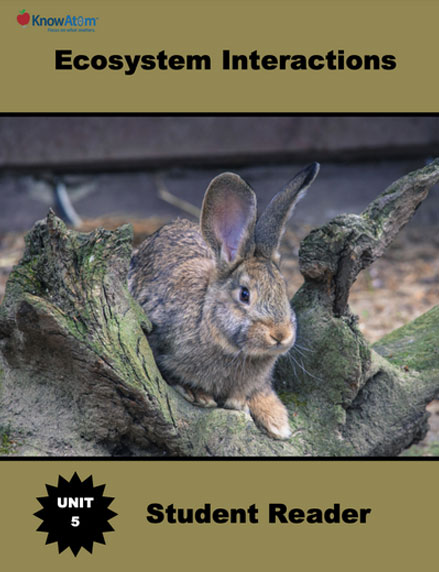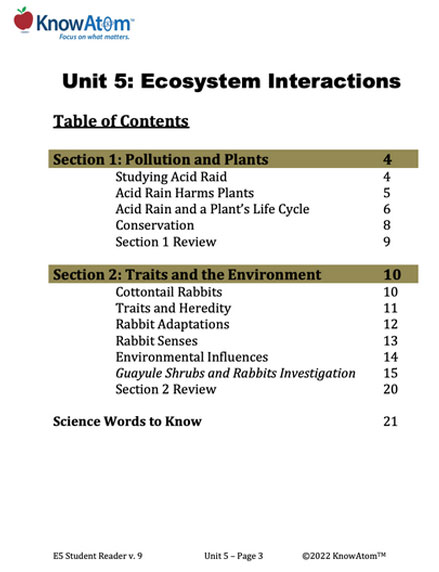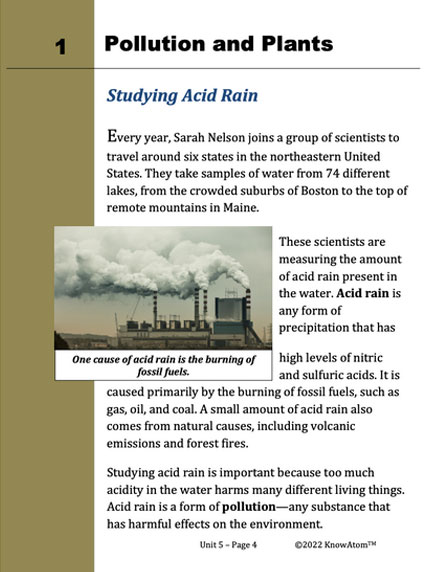The science background section provides teachers with more detailed information about the science phenomena students explore in this unit on ecosystem interactions.
Whenever an organism reproduces, it passes along traits to its offspring. A trait is a physical or behavioral characteristic of an organism. Number, size, and color of leaves are examples of plant traits.
Animals have different traits. For example, cottontail rabbits get their name from one physical trait: their poofy tails. Size and color are other examples of physical traits. Running in a zigzag pattern to avoid getting eaten is an example of a behavioral trait. A behavior is an organism’s response to a stimulus (anything in the environment that causes an organism to react).
The passing of traits from parents to offspring is called heredity. There are patterns that occur as traits get passed along. Heredity explains why offspring look similar to their parents. This is because they inherit traits from their parents. To inherit means to receive a trait from parents or ancestors.
Heredity explains why new plants have similar leaf shape, size, and color as their parents. It also explains why baby cottontail rabbits have the same poofy tails, long ears, and running abilities as their parents.
However, offspring don’t look or act exactly like their parents. There are always some differences. These differences are called variations. For example, some plants have a few more leaves than other plants. Some cottontail rabbits are bigger than others. Some rabbits can run faster than the other rabbits.
Sometimes, variations in traits can provide advantages in surviving, finding mates, and reproducing. For example, a rabbit that blends into the environment more than the other rabbits or runs faster might be better able to avoid predators.
Over time, these variations can become more common in the rabbit population because rabbits without the advantageous traits die out. They become adaptations—traits that help an organism survive in its environment. To change means to make something different from what it is now. Adaptations are developed across generations in response to the environment.
Cottontail rabbits have adapted strong senses to help them survive. A sense is how animals get information about the outside world. Senses include sight, hearing, touch, taste, and smell. Rabbits have large eyes that stick out on either side of their head. This allows them to spot predators from all directions. They also have large ears that allow them to hear predators that may be approaching.
Once an animal’s senses have gathered information from the environment, their sense receptors then pass that information to the brain. This process can be understood by thinking about the animal and its senses as part of a system. The information gathered by the senses is an input of information because it is received from the environment.
The brain then interprets the information so the animal can make sense of the environment at that moment. The information can also be stored as memories. Senses play an important role in an animal’s ability to survive because they affect an organism’s behavior. For example, if a rabbit senses a predator is nearby, it might run to the nearest hiding spot. Or it might freeze, hoping the predator won’t notice it.
Rabbits have other adaptations to help them survive in their environment. For example, the cottontail rabbit has adapted the ability to run at speeds reaching 29 kilometers (18 miles) per hour. Its ability to run in a zigzag pattern is another adaptation meant to confuse the predator. A predator is an organism that eats another organism. Raccoons, foxes, hawks, owls, snakes, cats, and dogs are all predators.
Predators also have senses that help them survive in their environment. For example, owls are nocturnal predators with a highly developed sense of sight. They have large eyes that are specially designed to see in the dark. They also have powerful talons and sharp beaks that help them catch and kill prey.
Because rabbits are prey for owls and so many other kinds of predators, they are very sensitive to their environment. In the wild, they generally know exactly where good hiding spots are so they can escape predators. They are often found in areas where there are different kinds of bushes and shrubs growing between forests and open grasslands. A shrub is a small plant with woody branches. Rabbits need the open areas for feeding because they are herbivores, eating only plant material. However, they need to live near areas where they can quickly hide from predators and protect themselves from bad weather. Because of this, rabbits depend on a stable environment. Stability refers to a condition in which the parts of a system are unchanging.
When their environment suddenly changes, cottontail rabbits are often in trouble. In some areas of the United States, populations of cottontail rabbits have declined as people have cleared the land for houses and other development.








